Digital adoption meaning is using new technology, such as digital assets, to optimal capacity and training employees to use new technologies correctly. Successful digital adoption increases productivity, leading to faster return on investment (ROI) on technology investments and reducing the cost of training resources.
- Digital Adoption Meaning in Business
- The Six Pillars Of Digital Adoption
- Digital Adoption Vs. Digital Transformation
- Why Are Adoption And Transformation So Important To ROI?
- ROI Meaning
- Digital Transformation Meaning
- Digital Transformation ROI
- Identifying Digital Transformation ROI Needs
- Digital Adoption vs. Software Adoption
- The Six Steps To Achieve Digital Adoption
- Benefits Of Digital Adoption
- What is a Digital Adoption Platform?
- Scope Of Digital Adoption
- How To Start Your Digital Adoption Strategy
- How To Scale Your Digital Adoption Strategy
- How Does A Digital Adoption Platform Work?
- Digital Adoption & Its Role In Digital Transformation
- Signs Of A Digital Adoption Problem
- Roadblocks To Achieving Digital Adoption
- The Digital Transformation Revolution Is Here
Digital Adoption Meaning in Business
We can also include digital business adoption meaning within this definition, as it means the same thing, and you will find it used in the same context as digital adoption.
After the global pandemic fundamentally changed the way we work, digital adoption became a top priority for organizations around the globe.
The rapid evolution of technology shows no sign of slowing down. From coffee shop apps to video conference software, digital tools are everywhere.
Digital transformations offer a solution to inefficient business processes. Using digital assets to their full potential and getting the most out of technology investments is at the core of digital adoption.
We’ve put together a comprehensive digital adoption guide, including the six key pillars, creating a winning digital adoption blueprint, the common obstacles companies run into, and how to avoid them.
The Six Pillars Of Digital Adoption
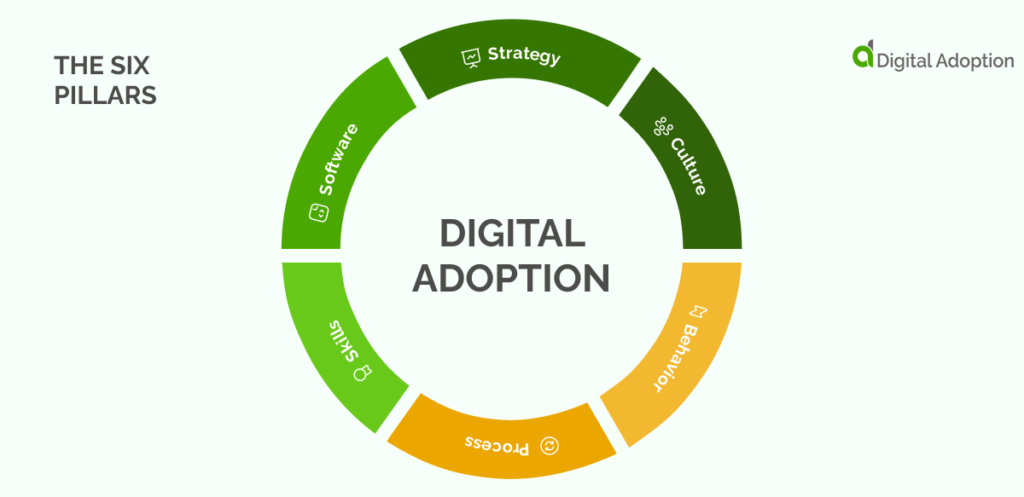
Our complete digital adoption guide comprises six crucial pillars. Neglecting just one of these pillars creates cracks in your strategy, and before you know it, the whole process comes crumbling down.
Strategy
To experience the full benefit of a successful digital transformation, you need a clear strategy. Most businesses neglect to communicate their strategy effectively. Employees should know how digital business adoption will change within their organization.
Culture
When discussing new digital adoption solutions, it can be easy to forget the most crucial aspect of digital adoption: the people. Using new systems challenges the company’s culture. If users don’t have a good experience with digital tools, that’s a clear sign something is wrong.
Behavior
New tech often leads to new processes in the workplace that feel unfamiliar to employees. For example, using screening software to streamline the recruitment process. An employee can feel overwhelmed learning new behaviors on a day-to-day basis. It’s essential to provide support and regular training to reduce the learning curve.
Process
Companies implement digital adoption as part of a wider-scale effort. There are many smaller processes involved, from senior management to individual employees. Efficiency is key when working on a large scale to avoid wasted time and achieve the expected results.
Skills
Despite employees’ concerns, new tech in the workplace isn’t threatening to make humans obsolete. The opposite is true. Workers can learn new skills and interact with digital tools in ways they haven’t before. Employees feel motivated when tech solutions provide a clear benefit to their work. You can minimize the learning curve and support staff at their own pace with comprehensive training.
Software
Software is the core of digital transformation. Smart and intuitive software has the power to transform work, making it more efficient and yielding more results. Whether updating a small app feature or replacing a digital system, keep in mind the effect on end-users.
Digital Adoption Vs. Digital Transformation
Digital transformation is the process of integrating technology into all areas of business. Technology can fundamentally change how a business operates, allowing companies to support remote work, streamline workflow, and offer more services to customers.
Your favorite coffee shop probably has an app to collect points and earn rewards, but are they making the most of the technology? Could they offer an option to purchase orders, make reservations or check the menu through the app?
Digital adoption describes a change in an organization’s approach to using technology, making it more than just using more digital tools. The focus is on preparation and creating a business culture that accepts change with open arms. Without digital adoption, digital transformation is impossible.
Why Are Adoption And Transformation So Important To ROI?
Companies must closely link digital adoption and transformation to ensure return on investment (ROI). We first need to examine a definition of digital transformation to understand the importance of the link between these three concepts.
ROI Meaning
ROI is a company’s attempt to ensure they get back in value more than what they put in with resources. ROI is a way for companies to measure the success of digital adoption and transformation strategies to ensure the strategy delivers meaning to digital adoption.
Digital Transformation Meaning
A digital transformation strategy involves dismantling and reassembling the tools and processes used to carry out business operations. The CEO and other leaders then put the apparatus of the organization back together more efficiently and cost-effectively.
Digital transformation is not simply the use of technology. It is the continuous process of businesses implementing technology at every business level to make digital processes improve business outcomes. With successful digital transformation, an organization increases employee performance, cuts waste, and increases revenue in higher quality and more varied customer services. This way, digital transformation, and ROI drive digital adoption, benefitting employees and customers.
Digital Transformation ROI
Digital transformation investment is closely linked to digital adoption and ROI, as success is impossible without all three frameworks and concepts. Beginning with return on investment, every company must ensure that every investment generates more value than the resources spent on the investment. Digital transformation strategies increase digital adoption, facilitating efficiency improvements and improved business outcomes.
Identifying Digital Transformation ROI Needs
Knowing where to start when companies attempt to link ROI to digital adoption and transformation can be difficult.
The best approach is for organizations to focus on specific areas, such as:
- Optimizing the value of existing assets using new methods
- Reducing support tickets response times
- Addressing the root cause of poor training materials
- Access to new technology
- Security and digital risk deficits
- Management and optimization of assets
- Rate of implementing new technology
- Health and safety policy corporate responsibilities
- Formulating engaging experiences for employees and customers user onboarding new
Focusing on specific areas allows companies to ensure that digital adoption as a part of a digital transformation strategy facilitates ROI. Now let’s open up digital adoption in detail to look at its six pillars.
Digital Adoption vs. Software Adoption
Choosing the right software is a significant investment and crucial to the success of a digital adoption solution. However, companies often make the mistake of relying too much on business software and neglect the other five pillars of digital adoption.
Digital assets become insufficient without the ability to use them. Without a strong company culture, a change in attitude toward digital technology, and proper training, the whole strategy will fall short.
It’s like working hours on a jigsaw puzzle only to discover a missing piece. You might get so far, but you won’t see the whole picture.
The Six Steps To Achieve Digital Adoption
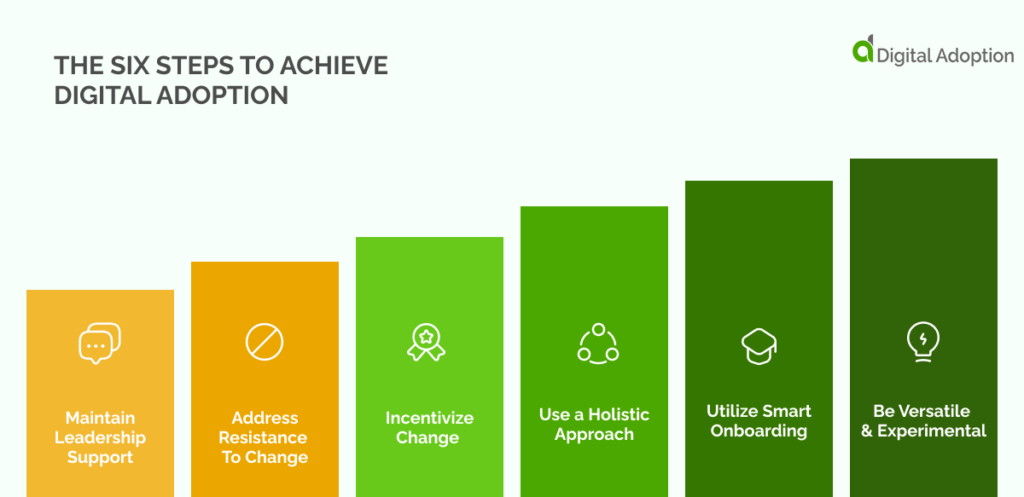
Finding the right digital adoption solution depends on the needs of the business. Consider the following six-step strategy as the ultimate digital adoption guide. The lessons shared here support a range of business and organization needs.
- Maintain Leadership Support
The first step might also be the most obvious. Digital transformation projects require full backing from the leaders of an organization. Business leaders can sign off on critical decisions, provide financial support, and set an example for the rest of the company. Upper management also needs to be able to see the full benefits of their technology investments.
During times of change, employees can feel disregarded. Change management involves responding to employee feedback and making necessary adjustments to the strategy.
- Address Resistance To Change
The two most common reasons that employees resist change are:
- Fear that they lack the skills to adapt to new processes.
- Concern that digital transformation initiatives won’t add any value to the company
If people worry about digital adoption, it means that they don’t fully understand how it works. A great solution to this problem is communication and support.
Every employee should know that they’ll be adequately trained on any new technologies. If they’re concerned that a more digital workplace will make their work less valuable, let them know that the opposite is true. New tools increase efficiency and make work more fulfilling if used correctly.
- Incentivize Change
Training on unfamiliar tech and learning new workplace behaviors can be daunting. Leaders understand that progress involves change, and communicating this to employees is challenging.
Most companies incentivize change through competition. For example, introduce rewards for each milestone that a team achieves in implementing new software.
Employees need support from their organizations during training and to be shown that their digital adoption efforts are paying off. Remind them that digital assets can:
- Boost sales
- Save time
- Increase productivity
- Streamline previously complex processes
- Use a Holistic Approach
It’s a common misconception that integrating new technology is an IT problem. Companies have found time and time again that adopting digital assets involves all sectors simultaneously.
Everyone needs to be on the same page. Otherwise, some processes get stuck because others are still doing things the old-fashioned way. We all value tradition, but progress involves looking forward, and the future is undeniably digital.
Consistency across software usage is also crucial. Users shouldn’t have to learn a new system every day or memorize a thousand different passwords. Streamlining the integration means keeping training as simple as possible.
- Utilize Smart Onboarding
Smart onboarding is all about accelerating new users and boosting retention of information and engagement with new systems.
Being ‘tech-savvy’ doesn’t quite cut it when learning to use new software. Training courses can often be too slow for experienced users or too quick for some to grasp complex concepts they haven’t come across before.
A great solution is a digital adoption platform. Digital adoption platforms cater to the pace of the individual user. These platforms can also automatically highlight new training areas introduced by new systems and tools.
- Be Versatile & Experimental
The best digital adoption strategies involve a lot of experimentation & research. You can measure the success of different processes by the reaction of users.
Are users frustrated trying to learn a new system? Are they continuing to do things the old way? Or avoiding certain software features altogether? It might be time to find a new digital solution.
Pushing an employee to adapt to poorly designed tech will only lead to resentment down the line. Be flexible in your approach, listen to your employees, and try out different processes until you find the best one.
Benefits Of Digital Adoption

As Gartner shows, ‘almost 50% of employees will continue to work remotely post COVID-19’ Increased work-life balance, flexibility, and less time commuting are some of the reasons many prefer the remote working environment. Business trends such as these will continue to appear as work becomes more digitized.
Only companies willing to adapt quickly and more effectively will thrive. Digital adoption is about making a company more adaptable and prepared for challenges.
Digital adoption involves a lot more than just using new technology. The benefits of a cohesive strategy include:
- Improved customer satisfaction
- Seamless workflow and increased productivity for employees
- A positive return on technology investments
Digital adoption makes training less expensive. Using a digital adoption platform requires fewer training resources and materials. Digital adaptation on the other hand is the ability to anticipate or perceive changing business landscapes and pivot through new varieties of technology, process, and workforce management.
What is a Digital Adoption Platform?
A digital adoption platform is like a private tutor for anyone who wants to learn how to use a digital tool more effectively. The platform integrates with software to guide users through critical tasks, familiarize them with new features, and ensure they get the most out of it.
Learning new software can be daunting and presents a lot of challenges. A digital adoption platform (DAP) solves that problem by simplifying the learning experience.
A great DAP also streamlines the feedback within an organization, funneling comments from users back to management automatically.
Scope Of Digital Adoption
A digital adoption solution is a company-wide strategy, but what is the true scope of digital adoption?
Recently, the world has faced challenges that come with remote work. Businesses that prioritized digital adoption were ready to adapt. Employees quickly received training and support to work remotely using video chat software.
Today’s market reflects an increase in customer and employee usage of digital tools. People are more comfortable using apps and software these days, and they expect these digital tools to work seamlessly. If a competitor’s app offers a feature that you don’t, customers will naturally gravitate towards their business.
How To Start Your Digital Adoption Strategy
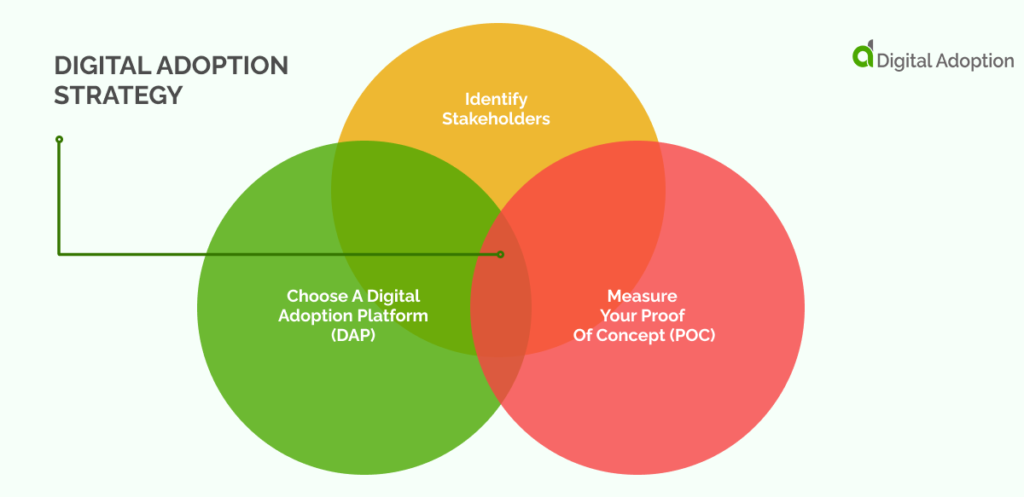
As with any successful strategy, being prepared is vital. Knowing who to target and which platform to use will make all the difference. A digital adoption solution comprises business processes, people, and technology working in harmony. If one element isn’t working, then the whole strategy is out of tune. So, how do you begin?
Identify Stakeholders
Before doing anything, you need to know who the stakeholders are. Stakeholders are anyone who has a say in software investments, addressing problems, and what the right solution is. If you skip this step, you run the risk of choosing the wrong solution.
Choose A Digital Adoption Platform (DAP)
When choosing a digital adoption platform, be mindful of the needs of your business and the support you need. What level of experience do your employees have? What kind of training solutions do they need? What is the purpose of the software you’re using? After answering these questions, you’ll be able to find the right digital adoption platform for your company.
Measure Your Proof Of Concept (POC)
Your POC is your trial run. It’s basically a short-term digital adoption project carried out before implementing a more in-depth strategy. A proof of concept helps identify risks early on, saves time and money, and offers a chance to see what works and what doesn’t.
It might seem like you’re making the process longer, but it’s better to make mistakes on a smaller scale to avoid them later on.
Key decision-makers will also want to see hard data that shows how a digital adoption solution scales up. Before they buy in on a larger project, they’ll want proof that it will lead to a return on investment.
How To Scale Your Digital Adoption Strategy
Once you’ve mastered the fundamentals of digital adoption, you can begin to scale up cost-effectively. Start with a detailed roadmap of your strategy.
This should include:
- Skills employees need to learn
- A detailed training plan with the correct support
- Technology that needs changing or updating
- A priority list of goals for your digital transformation
- Key team members and leaders who will guide the process
Divide key players into two teams:
- Executives who focus on changing business models
- IT departments and teams that oversee the digitalization
Make sure not to rush the digital adoption process. Being precise and flexible simultaneously can be a challenge but will make all the difference. Lastly, analyze the process each step of the way by asking crucial questions. Is the organization seeing increased productivity? Is training leading to increased competence? Are users satisfied with the results so far?
How Does A Digital Adoption Platform Work?
A digital adoption platform makes sure a business is getting the most out of the software they are investing in. Training becomes much more efficient as support is found within the software.
Identify key problem areas of software quickly, and reduce the influx of IT help desk tickets. Management can also use the analysis collected by the DAP to ensure correct practices.
The best DAP is one with multiple applications that offer more support to new users than was previously possible. It will be the only digital adoption platform you ever need if you find the right platform.
After all, efficiency at every level of the business will trickle down to customers’ experience. What could be more important than making customers happy?
Digital Adoption & Its Role In Digital Transformation

Digital transformation is the process of integrating technology in all areas of business. Technology can fundamentally change how a business operates. Companies can support remote work, streamline workflow, and offer more services to customers.
As we’ve established, digital adoption is about more than just using more digital tools. Digital adoption describes a change in an organization’s approach to technology. The focus is on preparation and creating a business culture that accepts change with open arms.
Without digital adoption, digital transformation isn’t possible.
Signs Of A Digital Adoption Problem
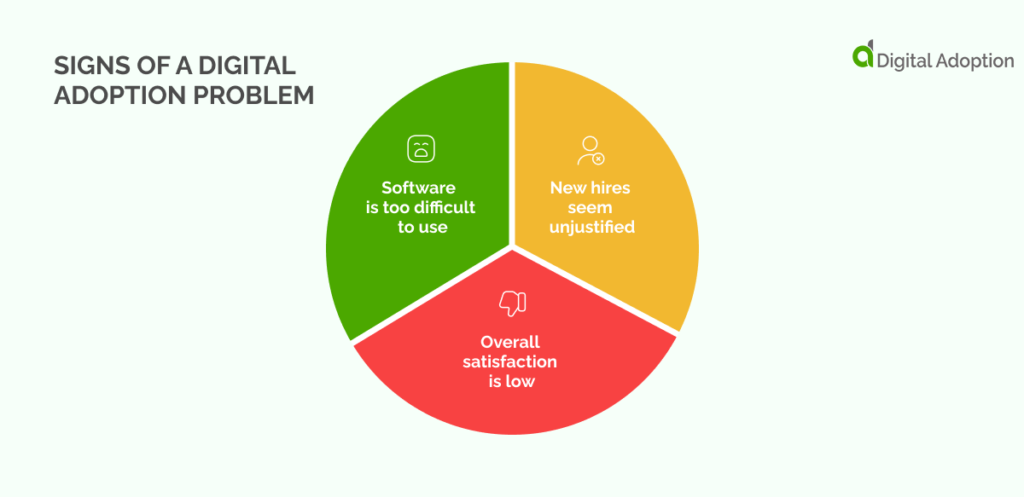
Digital adoption platforms exist to make digital adoption easier for a company. However, the problem sometimes lies with the attitude of an organization instead. Many businesses remain stuck in the past and continue to use outdated technology because they fear change. Users notice the lack of progress, and competitors quickly take advantage.
In addition to this, it’s easy to see when a digital adoption process is failing. Here are some of the signs to look out for:
Software is too difficult to use
If employees are still doing things the old way, they probably don’t understand the new digital assets they’re being asked to use. This problem can begin to snowball and rapidly become an unexpected expense. The solution is better training.
New hires seem unjustified
Using a new technology sometimes requires more hiring, but it’s crucial to keep track of this. It might not be necessary, and you might just need better training for existing employees.
Overall satisfaction is low
Users of digital tools are the most important voices to listen to. If a new app feature confuses customers, they may find somewhere else to get their coffee. If new technology frustrates employees, they won’t work as efficiently.
Roadblocks To Achieving Digital Adoption
Most businesses fail to implement their strategy because they neglect common roadblocks. Digital adoption platforms help identify obstacles early to avoid wasted time.
The main obstacles are:
- A lack of expertise
- Hard to use software options
- Poor leadership
- Measuring the ROI can be difficult
Finding a good digital adoption platform can also solve many of these issues. The expertise, training, and analytics make the whole process easier. Leading CIOs should also check in with employees and how they are handling the integration of new digital tools.
The Digital Transformation Revolution Is Here
A comprehensive guide to digital adoption has never been more necessary. A digital transformation revolution is taking place. The Covid-19 pandemic forced millions of workers to adapt to remote working and what began as an abrupt change in routine became the favored way of doing things.
At the core of this global change was digital technology. Companies invested in video communication software so their employees could work remotely. The organizations with the best digital adoption strategies thrived during unprecedented challenges.
The benefits don’t stop there. Customers are more familiar with technology and expect companies to reflect this in their services. Workers too, realize the effects of digital tools on how they work.
If a company has a poor strategy, its workers suffer the consequences. As mentioned throughout this guide, the response from users ultimately determines the success of a digital adoption solution.
Tech companies, in particular, will experience a shift in employee attitudes, an effect of the Great Resignation. Gartner’s recent Market Survey (Feb 2022) suggests that ‘38% of tech employees said they are likely to look for a new job with another organization within the next 12 months.’ Workers are gravitating towards positions with better remote-working policies.
Organizations that fail to achieve digital adoption will struggle to stay afloat in an evolving digital landscape. Only businesses with resilience and adaptability built into their foundations can weather the storm.

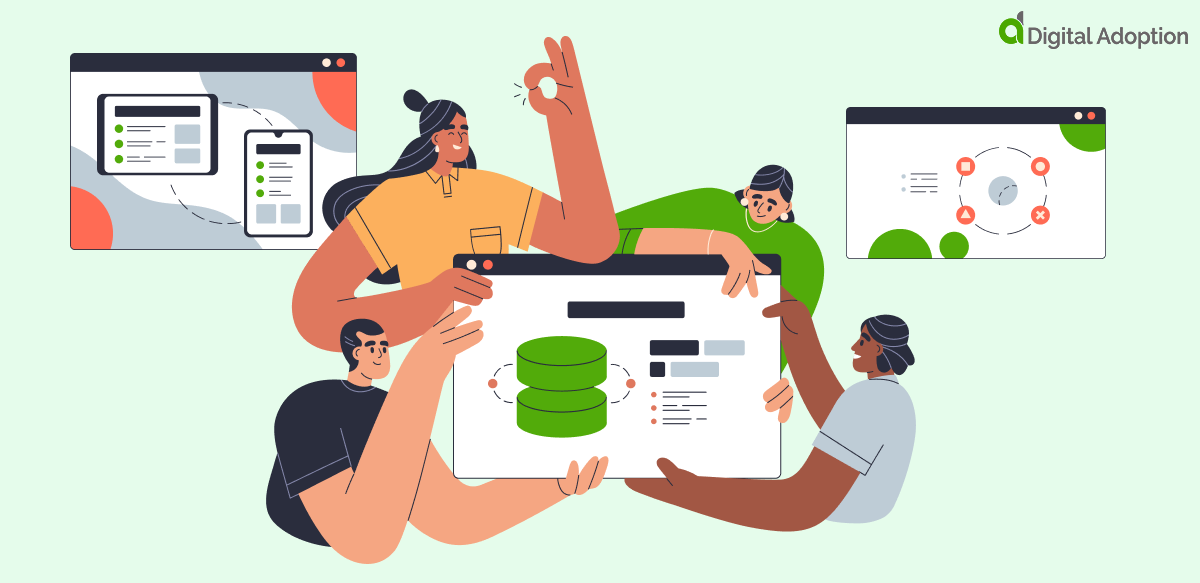


![18 Examples of AI in Finance [2025]](https://www.digital-adoption.com/wp-content/uploads/2025/06/18-Examples-of-AI-in-Finance-2025-300x146.jpg)
![14 Examples of AI in Manufacturing [2025]](https://www.digital-adoption.com/wp-content/uploads/2025/06/14-Examples-of-AI-in-Manufacturing-2025-300x146.jpg)
![29 Examples of AI in Education [2025]](https://www.digital-adoption.com/wp-content/uploads/2025/06/29-Examples-of-AI-in-Education-2025-300x146.jpg)
![15 Examples of AI in Retail [2025]](https://www.digital-adoption.com/wp-content/uploads/2025/06/15-Examples-of-AI-in-Retail-2025-300x146.jpg)
![13 Examples of AI in Healthcare [2025]](https://www.digital-adoption.com/wp-content/uploads/2025/06/AI-in-healthcare-examples-300x146.jpg)

![18 Examples of AI in Finance [2025]](https://www.digital-adoption.com/wp-content/uploads/2025/06/18-Examples-of-AI-in-Finance-2025.jpg)
![14 Examples of AI in Manufacturing [2025]](https://www.digital-adoption.com/wp-content/uploads/2025/06/14-Examples-of-AI-in-Manufacturing-2025.jpg)
![29 Examples of AI in Education [2025]](https://www.digital-adoption.com/wp-content/uploads/2025/06/29-Examples-of-AI-in-Education-2025.jpg)